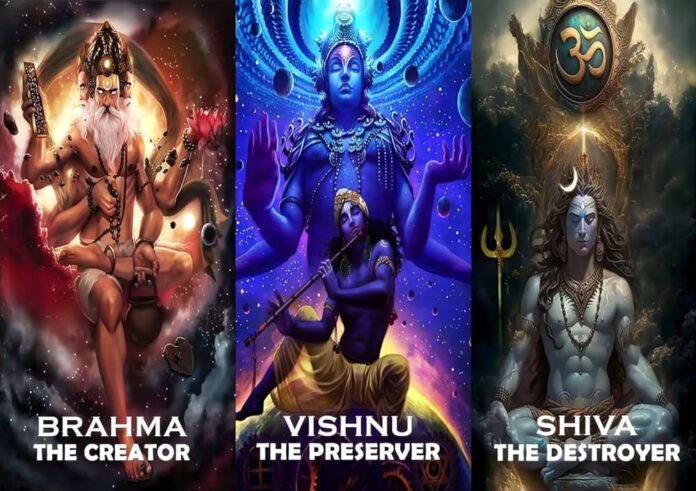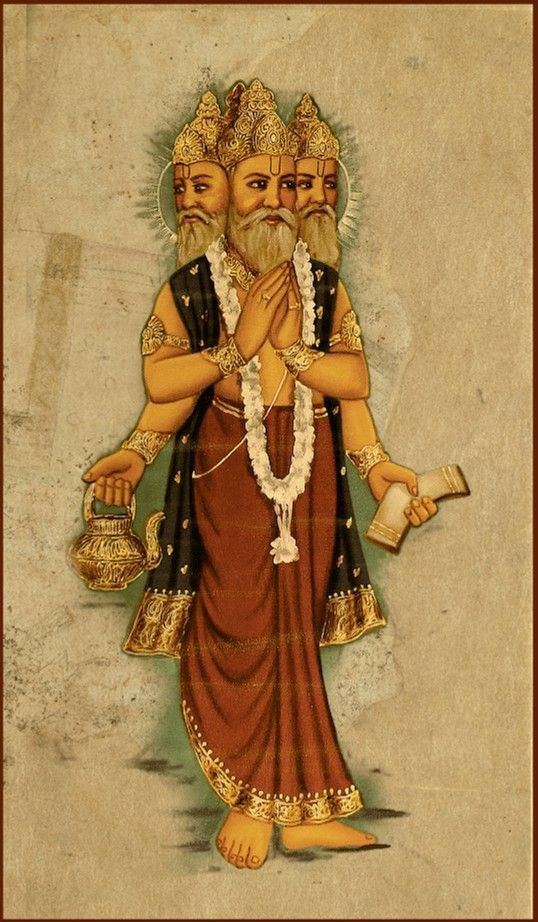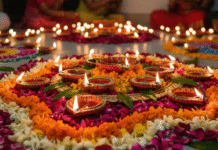
Preface
A clear understanding of the Hindu Trinity, which consists of Brahma, Vishnu, and Mahesh (or Shiva) is not only significant for realizing the significance of such notions in Hindu thought, but it is also central to the exploration of the more profound layers of Hindu cosmology.The word Trimurti means “three forms”,of God. This holy trio stands for the three main roles of God in the universe – creating, protecting, and finally, ending things.
In this article, we will evaluate their roles, symbols, mythological backgrounds, and spiritual significance of these three: Brahma, Vishnu, and Mahesh. Whether you are a spiritual seeker, a scratching reader, or a student of Hinduism, this article provides a thought-provoking yet comparative view of the Holy Trinity in Hinduism.
The Trimurti Explained: Brahma, Vishnu, and Shiva
| Aspect | Brahma | Vishnu | Mahesh (Shiva) |
| Role | Creator of the Universe | Preserver and Protector of the Universe | Destroyer and Transformer of the Universe |
| Mount | Swan (Hamsa) | Eagle (Garuda) | Bull (Nandi) |
| Consort | Saraswati (Goddess of Knowledge) | Lakshmi (Goddess of Wealth) | Parvati (Goddess of Power and Fertility) |
| Symbol | Vedas, Kamandalu (water pot), Rosary | Conch, Sudarshan Chakra, Mace, Lotus | Trident (Trishul), Drum (Damaru), Crescent Moon |
| Abode | Brahmaloka | Vaikuntha | Mount Kailash |
| Vahana | Hamsa (swan) | Garuda (divine eagle) | Nandi (bull) |
1. Brahma – The Creator

Who is Brahma?
As per Hindu Mythology Brahma is the creator of the universe and all beings. At times, he has been portrayed with four faces, which symbolize the four Vedas (Rig, Yajur, Sama, Atharva) and have the all-seeing nature of divine knowledge.He is believed to have emerged from a lotus that grew from Vishnu’s navel.
Key Symbols:
- Four heads and arms
- Lotus: purity and creation
- Vedas: wisdom
- Beard: symbol of wisdom and maturity
Why Is Brahma Less Worshipped?
Even though he was so important, he is not widely worshipped nowadays. The reason mythologically given for this is a variety of curses and stories, one of which involves him lying to Shiva, for which he was punished with limited worship.
2. Vishnu – The Preserver

Who is Vishnu?
The universe is maintained and protected by Vishnu. By cosmic dharma, he preserves cosmic order. In times of crisis, Vishnu incarnates himself in some avatar—to humans like himself—to restore balance. Among the most well-known avatars are Rama, Krishna, and Narasimha.
Popular Avatars of Vishnu:
- Rama – Model king and hero of the Ramayana
- Krishna – The divine strategist and philosopher in the Mahabharata
- Narasimha – The half-lion, half-man avatar who destroyed evil
Key Symbols:
- Shankha (Conch) – Represents the sound of creation
- Chakra (Discus) – Symbolizes mind and wheel of time
- Gada (Mace) – Power
- Lotus – Purity and transcendence
3. Mahesh (Shiva) – The Destroyer

Who is Shiv?
Shiva, or Mahesh, is the destroyer and transformer. He is not merely a destroyer but also a force for rebirth and rejuvenation as well. Shiva embodies both Yogi, the ascetic, or the ferocious Rudra. This duality makes him one of the most complex deities in Hindu religion.
Expressions of Shiva:
- Nataraja – The cosmic dancer symbolizing rhythm in the universe
- Ardhanarishvara – The fusion of Shiva and Parvati signifying balance between male and female energies
- Bhairava – The fierce form associated with annihilation and protection
- Nag Vasuki – Vasuki is a snake god and is often shown wrapped around Shiva’s neck. He is the king of all snakes. Vasuki stands for being brave, staying calm, and having control over our wants and fears. His presence shows that Shiva is powerful not just in the outside world, but also inside—he has full control over his body, mind, and spirit.
Key Symbols:
- Trishul (Trident) – Creation, maintenance, and destruction
- Damaru (Drum) – Sound of the universe (Om)
- Third Eye – Higher consciousness and destruction of ignorance
How They Function for Their Divine Purpose
| Function | Brahma | Vishnu | Shiva |
| Cosmic Role | Creation of the universe | Preservation of cosmic balance | Destruction for regeneration |
| Element | Earth (Stability) | Water (Fluidity and continuity) | Fire (Transformation and energy) |
| Direction | East | South | North |
| Worshipped As | Rarely | Widely across India | Intensely revered (Shaivism) |
Philosophical Quality
The Trimurti transcends mythology; it serves as a philosophical outline of life.
- Brahma stands for beginning—our birth, ideas, dreams
- Vishnu symbolizes sustainability—our daily lives, relationships, responsibilities
- Shiva implies letting go—of ego and fears, the past, that alone changes things
This closes the Hindu scaffoldings of time, mirroring cyclical time in contrast to linear time. Everything flows; everything is in a state of constant flux: creation, preservation, and dissolution.
Worship and Mandirs
- Tirupati Balaji and Jagannath Puri are among the prominent pilgrim destinations of Vishnu.
- Kedarnath, Kashi Vishwanath, and Chidambaram are popularly among the Shaivan devotees.
- The temples of Brahma are very few; the largest temple is Brahma Temple in Pushkar, Rajasthan.
Trimurti in Contemporary Culture
Trimurti in modern media and pop culture generally refers to:
- TV serials and epics like Har har Mahadev, Mahabharata and Ramayana
- Art and sculpture, especially seen in temples all over South India
- Philosophy of yoga, especially the balance of creation (energy), preservation (sustainability), and destruction (liberation)
SEO Keywords: Trimurti symbolism, Trimurti meaning in Hinduism, Hindu trinity explained
Understanding: One Essence, Three Faces
The Trimurti – Brahma, Vishnu, and Mahesh (Shiva) – do not comprise different gods riding each other’s tails into worship; rather, they are three of the most important aspects of life as manifested by the one Supreme Reality. Understanding these deities becomes a most valuable map of spiritual paths toward personal growth, balance, and transformation.
For seekers, these deities transform the passage from ignorance to wisdom, chaos to harmony, and stagnation to renewal.
Look forward to more insight-filled articles regarding Hindu deities, spiritual symbols, and Indian mythology. Please share this article if you found it helpful!






